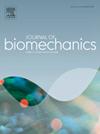Do osteophytes alter thumb carpometacarpal Biomechanics? a preliminary in vitro study
IF 2.4
3区 医学
Q3 BIOPHYSICS
引用次数: 0
Abstract
Osteoarthritis (OA) of the thumb carpometacarpal (CMC) joint is prevalent and debilitating, marked by substantial loss of range of motion (ROM) and overall function. CMC OA is associated with osteophyte growth, but the impact of this growth on CMC ROM has not been systematically characterized. Our goal was to determine whether osteophytes decrease CMC ROM and, if so, whether these decreases are direction-dependent. A robotic musculoskeletal simulation system was used to manipulate 18 CMC specimens with a range of joint health following three test protocols: (1) Rotational ROM in flexion, extension, abduction, adduction, and 20 combined directions, (2) Internal/External Rotation (IR/ER), and (3) Translational ROM in volar, dorsal, radial, ulnar, and 4 combined directions. Osteophyte volume (OV) was computed in total and by volar, dorsal, radial, and ulnar quadrants, and correlations with ROM were computed by direction and in total. We found that an increase in overall trapezial OV was associated with a reduction in overall rotational ROM and IR/ER, but not with translational ROM. We found decreased extension was associated with increased ulnar, volar, and radial OV, and decreased abduction was associated with increased volar OV. Decreased internal rotation was associated with increased ulnar, volar, and radial OV. The proposed method and findings of this pilot study will lay the groundwork for a larger investigation into the relationship between pathological structure and function in the CMC joint.
骨质增生会改变拇指腕掌骨生物力学吗?
拇指腕掌骨(CMC)关节骨关节炎(OA)是一种常见的衰弱性疾病,主要表现为活动范围(ROM)和整体功能的严重丧失。CMC OA 与骨质增生有关,但骨质增生对 CMC ROM 的影响尚未得到系统研究。我们的目标是确定骨质增生是否会减小 CMC ROM,如果是,这种减小是否与方向有关。我们使用机器人肌肉骨骼模拟系统对 18 个 CMC 标本进行了操作,并按照三个测试方案进行了关节健康范围的测试:(1)屈、伸、外展、内收和 20 个组合方向的旋转 ROM;(2)内/外旋(IR/ER);(3)外侧、背侧、桡侧、尺侧和 4 个组合方向的平移 ROM。我们计算了骨质增生体积(OV)的总和,并按外侧、背侧、桡侧和尺侧象限进行了计算,还按方向和总和计算了骨质增生体积与 ROM 的相关性。我们发现,整个斜方肌OV的增加与整体旋转ROM和IR/ER的减少有关,但与平移ROM无关。我们发现,伸展减少与尺侧、伏侧和桡侧OV增加有关,外展减少与伏侧OV增加有关。内旋减少与尺侧、足侧和桡侧OV增加有关。这项试验性研究提出的方法和结果将为进一步研究 CMC 关节病理结构与功能之间的关系奠定基础。
本文章由计算机程序翻译,如有差异,请以英文原文为准。
求助全文
约1分钟内获得全文
求助全文
来源期刊

Journal of biomechanics
生物-工程:生物医学
CiteScore
5.10
自引率
4.20%
发文量
345
审稿时长
1 months
期刊介绍:
The Journal of Biomechanics publishes reports of original and substantial findings using the principles of mechanics to explore biological problems. Analytical, as well as experimental papers may be submitted, and the journal accepts original articles, surveys and perspective articles (usually by Editorial invitation only), book reviews and letters to the Editor. The criteria for acceptance of manuscripts include excellence, novelty, significance, clarity, conciseness and interest to the readership.
Papers published in the journal may cover a wide range of topics in biomechanics, including, but not limited to:
-Fundamental Topics - Biomechanics of the musculoskeletal, cardiovascular, and respiratory systems, mechanics of hard and soft tissues, biofluid mechanics, mechanics of prostheses and implant-tissue interfaces, mechanics of cells.
-Cardiovascular and Respiratory Biomechanics - Mechanics of blood-flow, air-flow, mechanics of the soft tissues, flow-tissue or flow-prosthesis interactions.
-Cell Biomechanics - Biomechanic analyses of cells, membranes and sub-cellular structures; the relationship of the mechanical environment to cell and tissue response.
-Dental Biomechanics - Design and analysis of dental tissues and prostheses, mechanics of chewing.
-Functional Tissue Engineering - The role of biomechanical factors in engineered tissue replacements and regenerative medicine.
-Injury Biomechanics - Mechanics of impact and trauma, dynamics of man-machine interaction.
-Molecular Biomechanics - Mechanical analyses of biomolecules.
-Orthopedic Biomechanics - Mechanics of fracture and fracture fixation, mechanics of implants and implant fixation, mechanics of bones and joints, wear of natural and artificial joints.
-Rehabilitation Biomechanics - Analyses of gait, mechanics of prosthetics and orthotics.
-Sports Biomechanics - Mechanical analyses of sports performance.
 求助内容:
求助内容: 应助结果提醒方式:
应助结果提醒方式:


